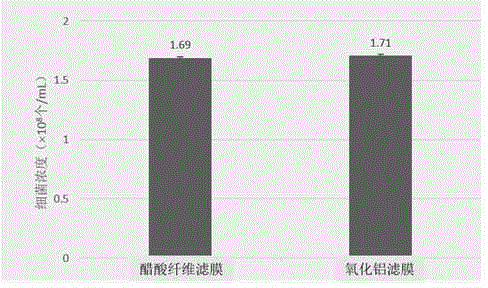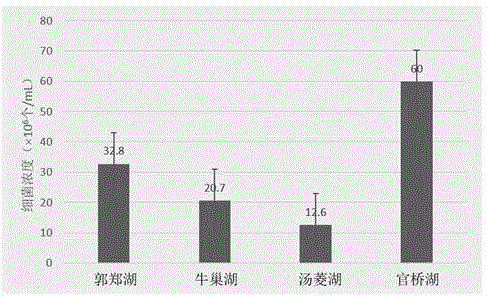Fluorescent microscopic counting method for detecting number of bacteria in water body
A technology of bacteria counting and fluorescence microscopy, which is applied in the field of environmental microbiology, can solve the problems of complex time-consuming and uncomfortable rapid detection, and achieve the effects of reducing detection cost, good observation effect, and reducing background fluorescence
- Summary
- Abstract
- Description
- Claims
- Application Information
AI Technical Summary
Problems solved by technology
Method used
Image
Examples
Embodiment 1
[0024] Embodiment 1 Preparation of anti-fading agent stock solution and anti-fading agent working solution
[0025] (1) Preparation of anti-fading agent stock solution
[0026] Dissolve 2g p-phenylenediamine, 0.8g sodium chloride, 3.2g disodium hydrogen phosphate, 0.25g Tris, 4g glycine in 80mL deionized water, adjust the pH to 7.2 with 0.1M hydrochloric acid or sodium hydroxide, add 100mL glycerol , and finally dilute to 200mL with deionized water to make anti-fading agent stock solution. Store the anti-fading agent stock solution in the dark at 4°C, and the validity period is 3 months.
[0027] (2) Preparation of anti-fading agent working solution
[0028] Take 1mL of the anti-fading agent stock solution, filter and sterilize it with a sterile needle filter, and then dilute to 10mL with sterile water to make the anti-fading agent working solution. The anti-fading agent working solution is prepared and used immediately.
Embodiment 2
[0029] Example 2 E. coli culture count
[0030] Cultivate Escherichia coli DH5α with beef extract-peptone liquid medium until the absorbance at 600nm is 0.2, take 2mL of bacterial liquid, centrifuge at 12000g for 10min, discard the supernatant, and resuspend the precipitate in 2mL of sterile saline for later use.
[0031] Take 100 μL of the above-mentioned spare bacterial suspension in a 5 mL centrifuge tube, add 10 μL of 10× SYBR Green I fluorescent dye, and stain in the dark for 5 minutes, then add 890 μL of sterile normal saline and 3 mL of anti-fading agent working solution, and keep it at room temperature in the dark 5 minutes, and then filtered through a 0.22 μm pore size cellulose acetate filter. Place the filter membrane on a clean glass slide so that the side with Escherichia coli is facing up, then drop a drop of anti-fading agent working solution on the filter membrane, cover it with a cover glass, and place it on the stage of the fluorescence microscope. Excit...
Embodiment 3
[0033] Example 3 Detection of Total Bacteria in Water Samples of Wuhan East Lake
[0034] In October 2014, 500mL mineral water bottles were used to collect water samples from four sub-lakes of East Lake in Wuhan (Guozheng Lake, Niuchao Lake, Tangling Lake, and Guanqiao Lake), and the incubators were refrigerated and transported back to the laboratory. Take 1 mL of each water sample into a 5 mL centrifuge tube, add 100 μL of 10× SYBR Green I fluorescent dye, and stain for 5 min at room temperature in the dark. Add the anti-fading agent working solution to each dyed water sample according to the volume ratio of the anti-fading agent working solution and the dyed water sample at a ratio of 3:1, mix well and keep it in the dark for 5 minutes. Afterwards, each water sample was filtered using a vacuum filtration device, and the filter membrane used was an ordinary cellulose acetate filter membrane with a pore size of 0.22 μm. After the filtration is completed, take out the filt...
PUM
 Login to View More
Login to View More Abstract
Description
Claims
Application Information
 Login to View More
Login to View More - R&D
- Intellectual Property
- Life Sciences
- Materials
- Tech Scout
- Unparalleled Data Quality
- Higher Quality Content
- 60% Fewer Hallucinations
Browse by: Latest US Patents, China's latest patents, Technical Efficacy Thesaurus, Application Domain, Technology Topic, Popular Technical Reports.
© 2025 PatSnap. All rights reserved.Legal|Privacy policy|Modern Slavery Act Transparency Statement|Sitemap|About US| Contact US: help@patsnap.com



